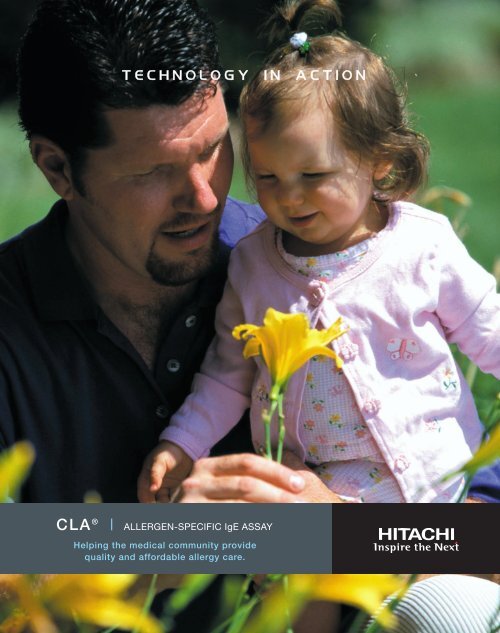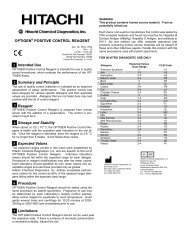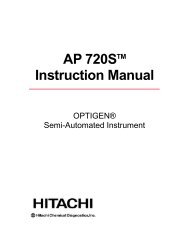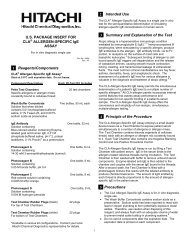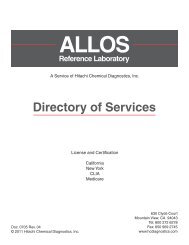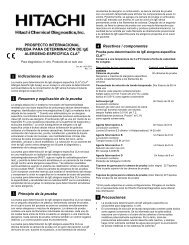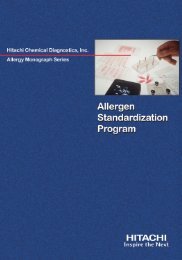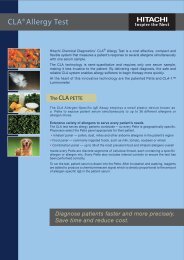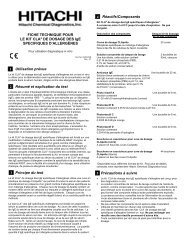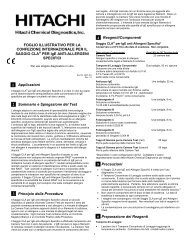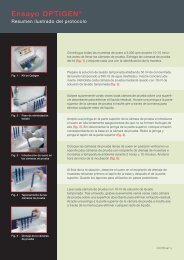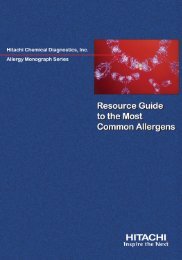CLA® Allergen-Specific IgE Assay Brochure - Hitachi Chemical ...
CLA® Allergen-Specific IgE Assay Brochure - Hitachi Chemical ...
CLA® Allergen-Specific IgE Assay Brochure - Hitachi Chemical ...
You also want an ePaper? Increase the reach of your titles
YUMPU automatically turns print PDFs into web optimized ePapers that Google loves.
T E C H N O L O G Y I N A C T I O NCLA ®| ALLERGEN-SPECIFIC <strong>IgE</strong> ASSAYHelping the medical community providequality and affordable allergy care.
Helping theMedicalCommunityOne out of every five people suffers from some formof allergy. 2, 3 Treating these allergies can be a challenge,but first an accurate diagnosis must be made.In today's cost-conscious healthcare environment, adoctor’s ability to refer allergy patients to a specialistmay be diminished. Patients also prefer efficient, highquality diagnosis that allows prompt and effective healthmanagement.Always known for technology and reliability, <strong>Hitachi</strong> offersthe medical community an alternative means of diagnosingallergy in a timely manner and at a significantly lower costthan has traditionally been available. We're proud to presentan accurate, easy to use serum test for allergy— the CLA<strong>Allergen</strong>-<strong>Specific</strong> <strong>IgE</strong> <strong>Assay</strong>.Quality & AffordableAllergy CareUsed as part of an initial allergy evaluation, the informationobtained allows optimal patient management by avoidingunnecessary and costly referrals of non-allergic patients,while allergic patients can be treated sooner andmore effectively.<strong>Hitachi</strong> QualityObjective AnalysisEasy to UseA Cost-EffectiveSystemCLA-1TechnologyComfortable forPatientsConsultation &EducationAccurate test results offer good correlation with skin testing. Access to the latestin vitro allergy testing technology.Up to 36 specific <strong>IgE</strong> results—optimized with the most regional or categoricallyprevalent allergens—from a 1.5 ml serum sample.CLIA Moderate Complexity system requires minimal training and provides plenty of“walk-away” time for staff to perform other duties.Easily incorporated with existing licensing, personnel and space. Low start-upcosts and incremental revenue help grow a physician’s practice.User-friendly instrument, including a small footprint on the lab bench. Reads up to180 allergens, or five panels, in less than ten minutes.A less intrusive technique that can be performed without stopping current medicationsand regardless of skin condition.A board-certified allergist is available to discuss test results, treatment options andother aspects of allergic disease. Educational materials for patients are also available.While once considered more costly than skin testing, modern screening methodsmake in vitro allergy testing no more costly than skin testing. Many insurers haveincorporated these cost-saving screens into their coverage guidelines. 42 Sly RM, Changing prevalence of allergic rhinitis and asthma, Annals of Allergy, Asthma & Immunology, Vol 82, March 1999, p233-248.3 Nolte, H, Undiagnosed Asthma & Allergy; Nursing & Patient Care– Allergy Diagnosis, Private Hospital Healthcare Europe; 2001.4 Corey, J P, Executive Summary, American Academy of Otolaryngic Allergy, March 1997.
The CLA <strong>Allergen</strong>-<strong>Specific</strong> <strong>IgE</strong> <strong>Assay</strong>The system, which consists mainly of the CLAPette and the CLA-1 Luminometer, simultaneouslymeasures the severity of a patient’sallergic reaction to up to 36 different allergensusing a single 1.5 ml serum sample.The CLA Pette, a small plastic device,is the fundamental component of thesystem. Each device contains up to36 cellulose threads, each boundwith a selected allergen.Counterpart to the CLA Pette,the CLA-1 Luminometer completesthe allergy testing system.This bench-top instrument readsprepared CLA Pettes, measuringthe amount of chemiluminescent> CLA-1 Luminometerlight emitted by the reaction to eachallergen. In less than ten minutes,it can analyze up to 180 allergens. The instrument automaticallyprints a complete report that lists the tested allergens and theseverity of the patient’s response to each.“The CLA assay for allergen specific <strong>IgE</strong> offersreliable results concordant with skin test….Potential advantages of in vitro assays (include)diagnosing inhalant allergy in selected patientsin whom skin tests cannot be performed.”Christensen, S N, Backer, V, DuBuske, L M, Nolte, H, In VitroDiagnostic Evaluation of Patients with Inhalant Allergies, Allergy andAsthma Proceedings, July-August 2003, Vol. 24, No. 4.> CLA PetteThe CLA-1 Luminometer performs a self-diagnostic each timeit is powered up to ensure correct results. FDA-cleared andCE-marked, it has shown consistent, reliable performance inlaboratories around the world.The system uses <strong>Hitachi</strong>’s patented chemiluminescence technology,one of the most sensitive detection systems available.This allows for the detection of very low levels of <strong>IgE</strong> in patientserum. <strong>Hitachi</strong> also holds patents on the CLA Pette and itsbinding technology.The CLA <strong>Allergen</strong>-<strong>Specific</strong> <strong>IgE</strong> <strong>Assay</strong> serves allergy patientsworldwide, so each panel is designed to be geographicallyspecific. Physicians simply select the panel that’s most appropriatefor their patient.• Inhalant panels – pollen, dust, mites and other airborneregional allergens.• Food panels – commonly ingested foods such as peanut,milk, tomato, soybean, wheat and others.• Combination panels – up to 36 of the most prevalent foodand inhalant allergens overall.The pre-determined panel format simplifies testing and reducesset-up time. It also eliminates inventory of individual allergensand decreases waste.Given their respective trajectories for technological advancement, quantification andquality control, in vitro testing may offer the more standardized approach (vs. SPT). 55 Poon, A, et al, In Vitro and Skin Testing for Allergy: Comparable Clinical Utility and Costs, The American Journal of Managed Care, July 1998, Vol. 7, No. 4.
Allos Reference Laboratory<strong>Hitachi</strong> <strong>Chemical</strong> Diagnostics is committed to improving the lives of allergy patients. Inaddition to its proven product line, the company also offers extensive service and supportwith its Allos Reference Laboratory—an ideal alternative for physicians who want toprovide their patients with a less invasive, world-class allergy diagnosis when internaltesting facilities are not available.Objective AnalysisThe Allos Reference Laboratoryhas one function only: allergytesting. Physicians simply submita patient’s serum sample andselect the CLA <strong>Allergen</strong>-<strong>Specific</strong><strong>IgE</strong> <strong>Assay</strong> panel of their choice.> Allos Reference Laboratory.Quick TurnaroundThe laboratory provides requestforms, pre-paid over-night expressmailers and serum vials to allits customers at no charge. Inapproximately three workingdays, physicians receive a precise,objective analysis of the patient’sreaction to each allergen.Consultation & EducationA board-certified allergist is available to discuss test results, treatment options and otheraspects of allergic disease. The lab also provides educational materials and patienthistory forms.
Inhalant PanelsCombination PanelsAllergies are the 6th leading cause of chronic disease in the UnitedStates, costing the health care system $18 billion annually. 11 American Academy of Allergy, Asthma and Immunology (AAAAI). The Allergy Report: Science Based Findings on the Diagnosis &Treatment of Allergic Disorders, 1996-2001.
With its headquarters in the heart of Silicon Valley and offices around the world, <strong>Hitachi</strong> <strong>Chemical</strong> Diagnostics is aglobal leader of in vitro allergy diagnostics with a legacy of innovation. <strong>Hitachi</strong> <strong>Chemical</strong> Diagnostics was the firstcompany to introduce a multiple in vitro diagnostic test for allergies and one of the first to introduce a chemiluminescentassay system for the detection of lgE antibodies. The company holds many in vitro allergy testing technologypatents and continues to pioneer advancements in the field.<strong>Hitachi</strong> <strong>Chemical</strong> Diagnostics, an integral member of the <strong>Hitachi</strong> Group, works with industry leaders, laboratoriesand distributors around the world to provide the medical community access to the latest in vitro allergy testing technology.<strong>Hitachi</strong> <strong>Chemical</strong> Diagnostics is committed to innovation, quality, and the strength of the <strong>Hitachi</strong> brand. Ourproducts are marketed to over 40 countries worldwide. To learn more about <strong>Hitachi</strong> <strong>Chemical</strong> Diagnostics andCLA, please contact us or your local representative, or visit us on the web at www.hcdiagnostics.com.United States OfficeEuropean Office630 Clyde CourtMountain ViewCA 94043-2239650.961.5501800.233.6278www.hcdiagnostics.com<strong>Hitachi</strong> Europe Ltd.Whitebrook ParkLower Cookham RoadMaidenhead, Berkshire, SL6 8YAUnited Kingdom44 (0) 1628.585.590CLA is a registered trademark and CLA-1 is a trademark of <strong>Hitachi</strong> <strong>Chemical</strong> Diagnostics, Inc.,in the United States and/or other countries worldwide.©2005 <strong>Hitachi</strong> <strong>Chemical</strong> Diagnostics, Inc. All rights reserved.Doc. No. 0702 Rev. 00


